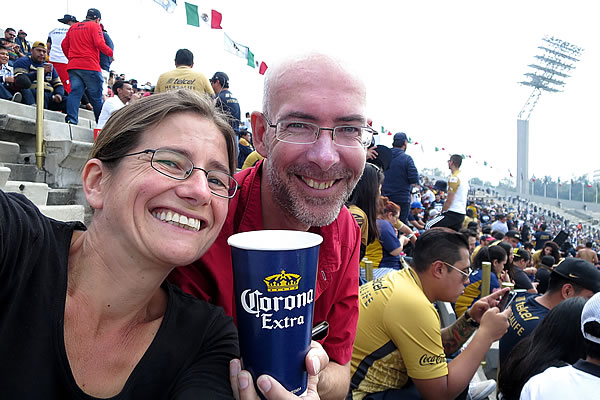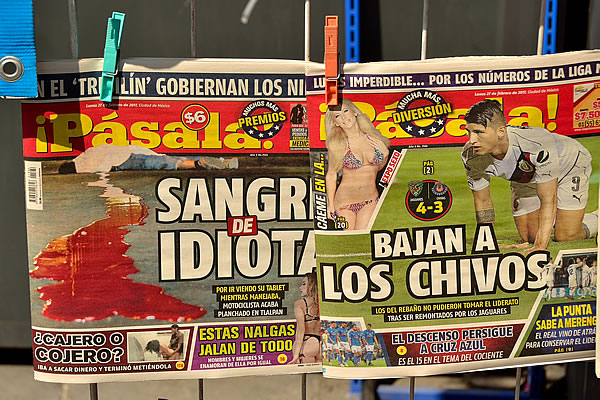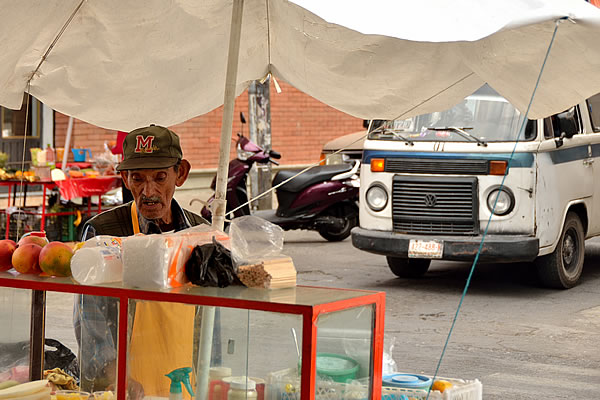

| Northern Mexico | |
Mexico City (Mexico) to Durango (Mexico), March 2017
|
|
|
|
|
We ended up staying a week in Mexico City, and we enjoyed it a lot. Before we arrived, we got several signals from different sources that Mexico City would be a "dangerous" city, and that we could better avoid it. And indeed, Mexico City does have a bad reputation, but the heavy crime is never directed at travellers, so we felt comfortable enough to visit the city. And our experience was that Mexico City did not feel different than any other (medium)large city in Mexico and that the presence of heavily armed patrols was even less visible than, say, in the city of Cancun on the touristy Yucatan Peninsula. The highlight of our visit to Mexico City was undoubtedly the visit to the football match between Club de Fútbol Universidad Nacional (The Pumas) and Club Santos Laguna. Football is the hearts of many Mexicans (both male and female) at for that reason, attending a football match is always big fun. After visiting Mexico City we travelled to the Michoacán province to visit the Monarch Butterfly Biosphere Reserve. In this area (among others, near the town of Zitacuaro), vast colonies of the Monarch Butterflies overwinter annually, roughly from October to March, that flock here from the great lakes region in North America. The total number is estimated at a billion butterflies, spread across multiple colonies of several hectares each. The colonies contain between 6 and 60 million monarch butterflies per hectare. They hang in big bunches on the trees. It is almost impossible to believe that these butterflies travel over 3,000 kilometres to come here to reproduce. Why they do it is still a mystery. We hired a guide and some horses to bring us to the higher altitude (around 2800 metres) steep slopes of the mountains, where the colonies are located. |
|
 |
|
Enjoying a soccer game in Mexico is big fun! |
|
Via the colonial towns of Morelia and Uruapan, we travelled to Mexico's second city, Guadalajara. It was here where we had to decide whether we wanted to visit northern Mexico, or that we would travel south along the Pacific coast. The biggest attraction in northern Mexico is the Copper Canyon, an area comparable to the Grand Canyon area in the United States. We would like to visit it, but the travel distances are large in Mexico, which made us reconsider our plans. Eventually we decided to go, partly because of the approaching Easter holidays. The Semana Santa week is in fact one of the main holiday periods in Mexico, in where every Mexican with a little money goes on vacation. And that means that every town that has something to offer to tourists is overflowing by local tourists. It is not the best and cheapest time to travel in Mexico, because many buses and hotels will be booked weeks in advance. We pondered and came to the conclusion that the best place for us to spend this busy holiday week is the place where no Mexican likes to go for a holiday; Mexico City! This is the city that everyone is fleeing, and for that reason it’s a good place for us to spend a week to await the holiday storm in the rest of the country. We found a good hotel deal for Mexico City during the Easter week on the internet; 9 nights in a four star hotel for 15 euros per night! And till that time we go to the north of Mexico, to visit the Copper Canyon. Our first stop on the way to the north was the resort town of Mazatlán, on Mexico's Pacific coast; a place where many North Americans spent the winter. The so-called "snow birds'. Then it was another day in the bus before we arrived in El Fuerte. El Fuerte is a town on the famous Copper Canyon Railway line. It is the most relaxing way to enjoy this fabulous Canyon area. The train ride to Chihuahua can be done in one long day of 16 hours, but it is much more enjoyable to make several stopovers in one of the several villages along the route, to admire the scenery (see also our article: Copper Canyon train journey). The total ride is 673 km long. A total of 86 tunnels and bridges 37 are passed during the ride. |
|
 |
|
Crime, women and soccer make the daily headlines in Mexico |
|
|
Chihuahua is the northernmost place we visited in Mexico. From here it is only a few hours’ drive from the border with the United States. But from Chihuahua we travelled south again with the planning to arrive in Mexico City on Saturday, April 8, the day before Palm Sunday. Our first stop was the town of Hidalgo del Parral. This unknown town in Mexico's “middle of nowhere” has a rich mining history. In 1640, Parral was declared the silver capital of the world, by the Spanish King Felipe IV. That was at the very height of the Spanish Empire. The mine has been operating for 345 years, and is now largely closed. One of the 25 levels is still open to visitors, and this level, 87 metres deep, can be reached by the original mine shaft elevator. From Parral it was another 7 hours by bus, through the desert, before we arrived in the city of Durango, the movie capital of Mexico. Durango is an urban oasis in an otherwise dry and arid desert landscape, an ideal area for making movies. Not only famous spaghetti westerns were filmed here such as 'The Good, the Bad and the Ugly’ and ‘Once Upon a Time in the West', but also parts of movies like ‘Ben-Hur (1959)’, Bond’s ‘Never Say Never Again (1983)' and 'Star Wars (1977)' were shot here. That means that almost all of the film industry’s greatest names have been in this dusty desert town, as ‘proofed’ by the "Durango Hall of Fame” tiles in the centre of the city, with names like Burt Lancaster, Audrey Hepburn, Steven Spielberg, Francis Coppola, Jack Nicholson, John Wayne, Mel Gibson and Clint Eastwood. So, Durango is a real movie pilgrimage destination! |
|
 |
|
Street vendor in Zitacuaro |
|
 |
|
Kids enjoy the fountain in Guadalajara |
|
 |
|
Typical landscape in Northern Mexico |
|
 |
|
Selfi on the Copper Canyon Railway
| |
 |
|
The still in use old mine shaft elevator in Hidalgo del Parral © copyright - Babakoto.eu / 2017 |
|